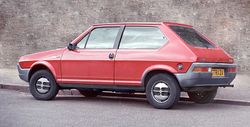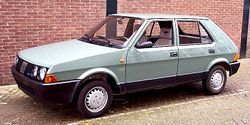Difference between revisions of "Fiat Ritmo"
m |
m |
||
| Line 51: | Line 51: | ||
| Designer || [[Bertone]] | | Designer || [[Bertone]] | ||
|} | |} | ||
| − | |||
| − | |||
| − | |||
| − | |||
| − | |||
| − | |||
| − | |||
| − | |||
| − | |||
| − | |||
| − | |||
| − | |||
| − | |||
| Line 97: | Line 84: | ||
==See also== | ==See also== | ||
* The [[Fiat Strada]] light [[Pickup truck|pick-up]] produced in Brazil. This car is based on the [[Fiat Palio]] 'world-car' platform and has nothing in common with the Ritmo-based Strada of UK and US markets. | * The [[Fiat Strada]] light [[Pickup truck|pick-up]] produced in Brazil. This car is based on the [[Fiat Palio]] 'world-car' platform and has nothing in common with the Ritmo-based Strada of UK and US markets. | ||
| + | |||
| + | == Gallery == | ||
| + | |||
| + | [[Image:Fiat-Strada-Side.jpg|thumb|250px|Fiat Strada (Ritmo) 1st series.]] | ||
| + | |||
| + | [[Image:Fiat Ritmo 2d Utrecht.JPG|thumb|250px|Fiat Ritmo 2-door 2nd (1982) series.]] | ||
| + | |||
| + | [[Image:Fiat Ritmo Cabriolet Roma 1983 reduced res modified.jpg|thumb|250px|Fiat Ritmo 2-door 2nd (1982) series cabriolet.]] | ||
| + | |||
| + | [[Image:Fiat Ritmo Cabriolet Bertone.JPG|thumb|250px|Fiat Ritmo 2-door 2nd (1982) series cabriolet with open top.]] | ||
| + | |||
| + | [[Image:Fiat Ritmo 60L 1987.jpg|thumb|250px|Fiat Ritmo 3rd (1985) series.]] | ||
| + | |||
| + | [[Image:Fiat Strada 130 tc Abarth.jpg|thumb|250px|Fiat Strada 130 TC Abarth (1985) Series 2.]] | ||
| + | |||
| + | |||
==External links== | ==External links== | ||
Revision as of 19:45, 27 October 2009

| |
| Fiat Ritmo | |
|---|---|
| Aka | Fiat Strada |
| Manufacturer | Fiat |
| Parent company | |
| Production | 1978–1988 |
| Predecessor | Fiat 128 |
| Successor | Fiat Tipo |
| Class | Small family car |
| Platform | |
| Layout | FF layout |
| Body style | 3-door hatchback 5-door hatchback 2-door cabriolet |
| Engine | 1.0 L I4 1.1 L I4 1.3 L I4 1.5 L I4 1.6 L I4 2.0 L I4 |
| Transmission | 4 and 5-speed manual 3 speed automatic (VW) |
| Wheelbase | 2448 mm MkI 2444 mm MkII 2432 mm (125 & 130TC) |
| Length | 3937 mm |
| Width | 1650 mm 1663 mm (Sport/Abarth) |
| Height | 1400 mm |
| Front track | 1400 mm |
| Rear track | 1410 mm |
| Weight | 850-995 kg (1873-2193 lb) |
| Related | Lancia Delta Fiat Regata SEAT Ronda SEAT Malaga SEAT Ritmo SEAT Ibiza |
| Similar | Volkswagen Golf Ford Escort Toyota Tercel Talbot Horizon Opel Kadett |
| Designer | Bertone |
The 1978 Fiat Ritmo, styled by Bertone of Italy, was the most distinctive looking small family car in Europe on its launch. It was badged in Britain and the U.S. as the Fiat Strada but failed to attract many Ford Escort/Austin Allegro buyers because of its unconventional appearance. Legend has it that the reason for the name change was that "Ritmo" was a make of ladies sanitary towel in the U.S.
History
Underneath its quirky looks the Ritmo used most of the front-wheel drive running gear which could be found in the more conventional looking 128, which continued until 1984. Ride and handling were considered adequate if bouncy, steering vague, imprecise and extremely heavy, and the gearbox was much-criticised. A cheaper alternative to many other cars in its class from manufacturers such as Ford and Renault, the Ritmo struggled to attract buyers outside its native Italy and Spain. The 1.1 L (60 bhp), 1.3 L (65 bhp) and 1.5 L (75 bhp) petrol engines were reasonably refined and economical, but were underpowered for the size of the car, and unexciting. In 1980 the Ritmo diesel was introduced with the 1714cc engine (55bhp) from the 132. In the following year the Ritmo Super was introduced with a variety of small changes and, most significantly, revised engines with 75bhp (1300) and 85bhp (1500). Also in 1981 was born the first sporting Ritmo, the 105TC. This used a 1585cc Fiat DOHC engine derived from that in the 131 producing 105bhp. A few months later the Ritmo Abarth 125TC was introduced. This was a heavily modified 105TC with a 1995cc DOHC with 125 bhp, ventilated front discs, a new ZF gearbox, revised suspension settings and strengthened components.
Technologically, the biggest innovation of the Ritmo was not the car itself, which took the underpinnings of the 128, but the way in which it was manufactured. Fiat, already an industry pioneer in automated assembly, took the ambitious step and made the Ritmo the first car to be almost completely built by robots, earning the car the advertising tagline "Hand built by robots". In the UK, a memorable television advert, showing the robots assembling the car to the strains of Rossini's The Barber of Seville was shown.
The so-called "Robotgate" system made the car cheaper and quicker to manufacture, but the Ritmo also suffered a terrible reputation for poor build quality, unreliability, fragile interior trim and electrical problems. Few Ritmos survive; they were hit hard by the infamous "rust-bug" which afflicted most Italian cars of the 1970s and 1980s thanks to the use of low-grade Soviet steel which was supplied as part of the deal to supply Soviet manufacturers with car designs and production tooling. In addition, there were mechanical problems, such as the very rapid wearing of the gearbox which some owners suffered. Selecting a gear in a hurry resulting in crashing and scraping sounds from underneath, and extremely jerky progress.
The resulting bad publicity severely dented Fiat's reputation in export markets, and although it was successful in its home Italian market, the car failed to make much impact elsewhere in the world. The severe rust and unreliability problems for which the car was infamous, led to Fiat's withdrawal from the U.S.
1982
A 1982 facelift saw the Ritmo's styling become much more restrained and the name changed from Strada to Ritmo for the US market. (It became the Strada II in the UK.) A hot hatch version — the 130 TC — was added, with a 2.0 L engine and capable of nearly 120mph. It was sporty-looking and huge fun to drive but not an ultimate hot hatch in the same vein as the Volkswagen Golf GTI.
A saloon version, the Regata, was also launched without great success outside Italy.
The Ritmo Cabriolet was launched in 1983 but low demand saw production end after just two years. It looked striking and was better cheaper than a Golf Cabriolet but not up to Volkswagen standards in terms of quality or ability.
The year 1988 saw the last Ritmo roll off the production line and the more conventional Tipo take its place.
The Spanish twin
Spanish car maker SEAT began their history as a Fiat licensee, making rebadged clones of Fiat cars, until the agreement was dropped in 1982. From 1979 to 1982 a Spanish version of the Ritmo, the SEAT Ritmo, was produced in Spain near Barcelona. When the licence expired, SEAT had to change the least possible number of pieces in their model range so that Fiat could not sue them on the basis of patent infringement, and the SEAT Ritmo yielded the SEAT Ronda, under production until 1986. Before the Volkswagen Group takeover, SEAT showed to the press a black Ronda unit with all the in-house developed parts painted in bright yellow to clear all doubts about their rights to go on assembling the car, and also about the future of the firm SEAT and their factories.
Later, a 4-door version of the Ritmo was developed on the same underpinnings, called the Málaga. SEAT's subsequent takeover by Volkswagen saw the Fiat heir models being quickly killed off, including the Málaga.
See also
- The Fiat Strada light pick-up produced in Brazil. This car is based on the Fiat Palio 'world-car' platform and has nothing in common with the Ritmo-based Strada of UK and US markets.
Gallery
External links
| Preceded by: Fiat 128 |
Succeeded by: Fiat Tipo |
| <- Older Models | Fiat car timeline, European market, 1980s - present | |||||||||||||||||||||||||||||||||||||||
| Type | 1980s | 1990s | 2000s | 2010s | ||||||||||||||||||||||||||||||||||||
| 0 | 1 | 2 | 3 | 4 | 5 | 6 | 7 | 8 | 9 | 0 | 1 | 2 | 3 | 4 | 5 | 6 | 7 | 8 | 9 | 0 | 1 | 2 | 3 | 4 | 5 | 6 | 7 | 8 | 9 | 0 | 1 | 2 | 3 | 4 | 5 | |||||
| City cars | 126 | Cinquecento | Seicento (1998-2005) / 600 (2005-2010) | |||||||||||||||||||||||||||||||||||||
| 500 | ||||||||||||||||||||||||||||||||||||||||
| Panda I | Panda II | |||||||||||||||||||||||||||||||||||||||
| Supermini | 127 | Uno | Punto I | Punto II | ||||||||||||||||||||||||||||||||||||
| Grande Punto | Punto Evo | |||||||||||||||||||||||||||||||||||||||
| Small family car |
Ritmo | Tipo | Bravo / Brava | Stilo | Bravo II | |||||||||||||||||||||||||||||||||||
| 131 | Regata | Tempra | Marea | Linea | ||||||||||||||||||||||||||||||||||||
| Albea | ||||||||||||||||||||||||||||||||||||||||
| Large family car | 132 | Argenta | Croma I | Croma II | ||||||||||||||||||||||||||||||||||||
| Coupé | Coupé | |||||||||||||||||||||||||||||||||||||||
| Roadster | 124 Spider | Barchetta | Barchetta | |||||||||||||||||||||||||||||||||||||
| Sports car | X1/9 | |||||||||||||||||||||||||||||||||||||||
| Panel van/Leisure activity vehicle | Fiorino I | Fiorino II | Fiorino III | |||||||||||||||||||||||||||||||||||||
| Doblò | ||||||||||||||||||||||||||||||||||||||||
| Mini SUV | Sedici | |||||||||||||||||||||||||||||||||||||||
| Mini MPV | Idea | |||||||||||||||||||||||||||||||||||||||
| Compact MPV | Multipla | |||||||||||||||||||||||||||||||||||||||
| Large MPV | Ulysse I | Ulysse II | ||||||||||||||||||||||||||||||||||||||
| Van | Daily* | Scudo I | Scudo II | |||||||||||||||||||||||||||||||||||||
| Ducato I | Ducato II | Ducato III | ||||||||||||||||||||||||||||||||||||||
| Mini Pickup | Strada | |||||||||||||||||||||||||||||||||||||||
| Off-road | Campagnola (1107) | |||||||||||||||||||||||||||||||||||||||
| *Rebadged Iveco model | ||||||||||||||||||||||||||||||||||||||||









